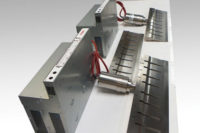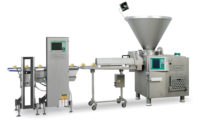Consumer demand for baked goods and snacks that are ready-to-eat, portable and single-serve continues to grow. It’s not surprising, then, that more individually packaged, grab-and-go cookies, bars, pastries, cheesecake slices, sandwiches and other products are turning up on retail shelves.
“We are seeing an increased demand for slicing equipment,” says Sandra Ryan, vice president of operations, Ryan Technology Inc., Hillsboro, OR. “Consumers are after convenience products, and that means pre-sliced bakery products that are ready-to-eat. Single-serve is also a big driver. We’ve seen an increase in inquires coming from customers that are looking to slice before the product goes into a flow wrapper.”
Ryan Technology recently made several improvements to its Model 793B Rotary Table Utility Slicer, a dual-blade, horizontal slicer for products like buns, ciabatta, bagels, rolls, hoagies and croissants. The emergency stop button is now more accessible from almost anywhere around the machine, according to Ryan, and the blades are now coated with Ryton to reduce residue buildup and aid with sanitation. “This becomes more important with products that contain inclusions, such as raisins or onions,” she explains. “Our customers are preferring the Ryton coating over the nickel Teflon we used before and find that it performs better.”
Egan Food Technologies, Grand Rapids, MI, is also seeing increased demand for its equipment due to interest in smaller, single-serve snacks, says Mike Bond, sales manager. “The bar industry is growing by millions of dollars each year,” he notes, adding that the company offers slitter wheels, spreader assemblies and servo-controlled guillotine cutters for the bar industry. “These are major components of slab lines.”
This year, the company introduced a high-speed wire-cut extruder capable of making up to 150 cuts per minute for frozen and standard cookie dough products, as well as protein and nutrition bars that are extruded and cut with a wire or knife. “The most-notable design improvement is with the wire harp mechanism,” explains Bond. “We have attached it to a linear servo actuator that retracts farther back than the current design to allow for easier maintenance and cleaning. This is considered the ‘park’ position and allows quick and simple access to a broken wire for quick changeover.” Egan Food Technologies also redesigned the extruder head, reducing the number and size of components needed, which results in a lower price point.
Bond adds that the more-cuts-per-minute capability enables customers to potentially make more products in a given time period, if their downstream equipment can handle the increased speeds, which translates to faster return on investment.
“Consumers today are embracing premade, fresh, gourmet sandwiches and wraps—with a three-day shelf life—in retail venues such as convenience stores and coffee shops—outlets that traditionally offered only premade sandwiches with gas-flush packaging,” says Andy Schneider, sales manager–Americas, Grote Co., Columbus, OH.
The company recently expanded the capabilities of its 613 Multislicer, and now offers an optional pass-through conveying and targeting system on new 613-VS2 models. The compact system lets manufacturers slice and place baked goods such as Melba toast, bagel chips, biscotti and sliced cookies directly onto baking trays and screens.
“This system offers bakers and snack food manufacturers a significant return on investment by reducing labor associated with the slicing-and-toasting and baking-and-drying processes,” says Schneider, adding that it also meets the highest hygiene and sanitary design standards.
Easy does it
When it comes to delicate, soft or layered baked or frozen goods, many consumers are more than happy to purchase a precut product, regardless of whether it’s a single- or multi-serve item.
“FoodTools has seen a steady demand for many years,” says Doug Petrovich, vice president of sales and marketing, FoodTools, South Haven, MI, which offers mechanical and ultrasonic portioning machines for products ranging from cakes and frozen dairy products to tortilla chips and frozen pizza.
The company’s CS-2100RF Dual Platform Roll Feeding Slicer—the latest version of its mechanical slicer for frozen or refrigerated round cakes and pies—can insert dividers from a roll, rather than sheets, reducing inventory requirements and minimizing paper misfeeds, Petrovich explains. A servo-driven product holder provides speed and accuracy, while a rotating platform allows the operator to load and unload product while it is being sliced, maximizing efficiency. The model can be converted to an ultrasonic slicer.
FoodTools’ latest version of its standalone ultrasonic frozen or refrigerated sheet cake, round cake and pie slicer—the ACC-10UTS Ultrasonic Cake Slicing Machine—features servo-driven technology for speed and accuracy and an integrated blade-cleaning system. Available with one, two or three blades, the unit can slice quarter, half, full sheets and can be fitted with round product holders for total flexibility.
According to Petrovich, both machines are constructed from stainless steel, ultrahigh molecular weight (UHMW) polyethylene and hard coat aluminum; have a welded construction; and are as energy-efficient as possible.
Telsonic UK Ltd., Poole, England, offers ultrasonic cutting and portioning systems for cakes, chocolate-coated products, cereal bars and pizza. According to the company, ultrasonic cutting uses the high-frequency oscillation of the sonotrode (cutting blade) to quickly and cleanly pass through the product. The oscillations can range from 20–35 kilohertz, depending on the application.
Soft and sticky products are especially well-suited for ultrasonic cutting and portioning systems because, unlike conventional mechanical cutting systems, ultrasonic systems don’t smear or crush items. When used to cut foods that do make cleaning the ultrasonic sonotrode necessary, the operator can simply submerge the sonotrode in a water bath station and initiate an ultrasonic pulse cycle.
New product capabilities
Consumer interest in products sporting new shapes, sizes, formulations and ingredients are also driving equipment innovation.
Tim O’Brien, vice president of sales at Urschel Laboratories, Chesterton, IN, says the company is seeing more interest in new potato chip cuts, prompting two new knives for its Model CC Potato Chip Slicer—the Flat-V and the Z-Cut. The latter, he explains, gives chips “a more defined, higher-amplitude profile, which seems to be the current trend or fad in the potato chip industry.” Growing interest in lattice-cut potato chips, meanwhile, has resulted in greater sales of Urschel’s Model CCL Lattice Potato Chip Slicer.
Urschel also recently introduced the Affinity Dicer, a three-dimensional dicer for producing croutons and stuffing mixes. The machine’s large size reduces or eliminates the need for precutting bread, depending on loaf size. “Depending on the stale time, sometimes bread can be difficult to precut,” says O’Brien. “You want it stale enough, so that it’s not wet and gummy, but you don’t want it staled so much that you’re going to create a lot of fines when you’re cutting.”
The Affinity Dicer also features two positive feed mechanisms—a feed spindle and a feed drum—that also make it easier for operators to feed difficult-to-cut items through the machine. He notes that the machine was designed with sanitation in mind.










